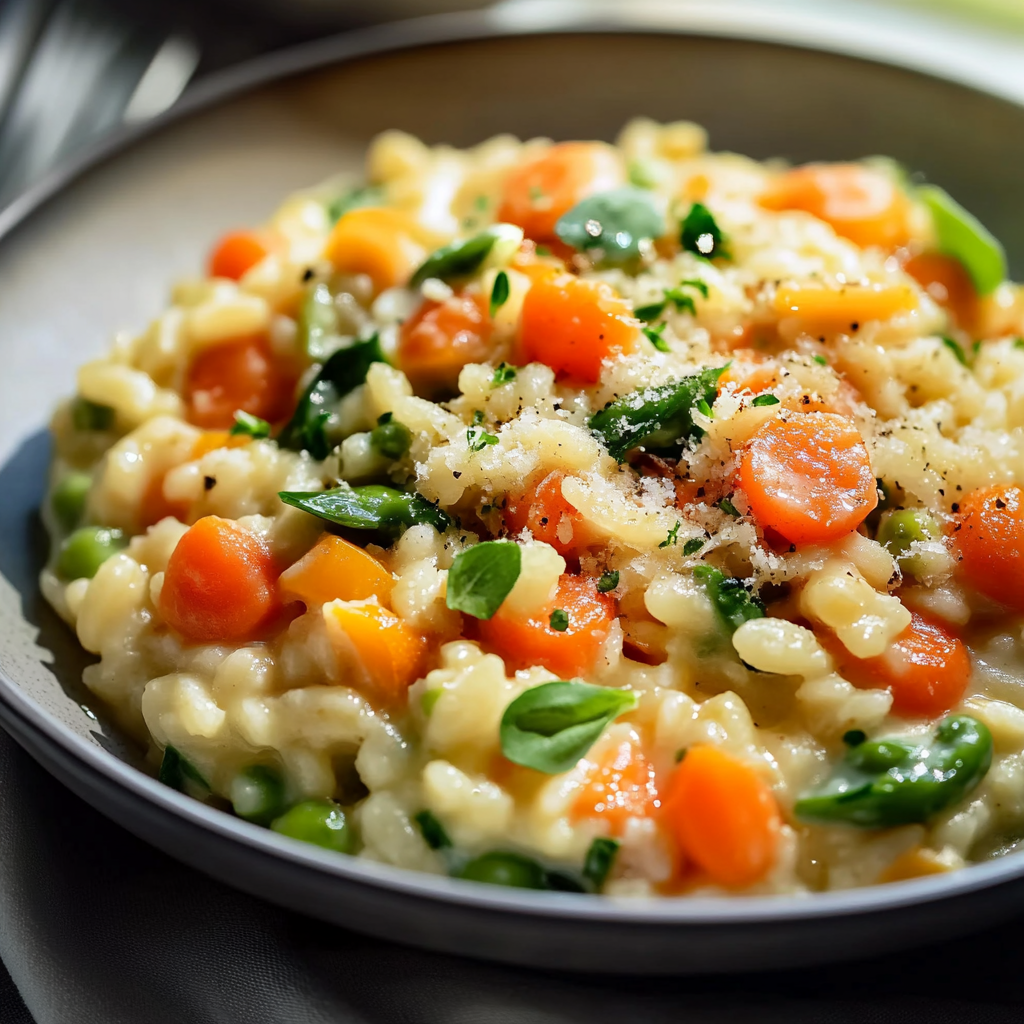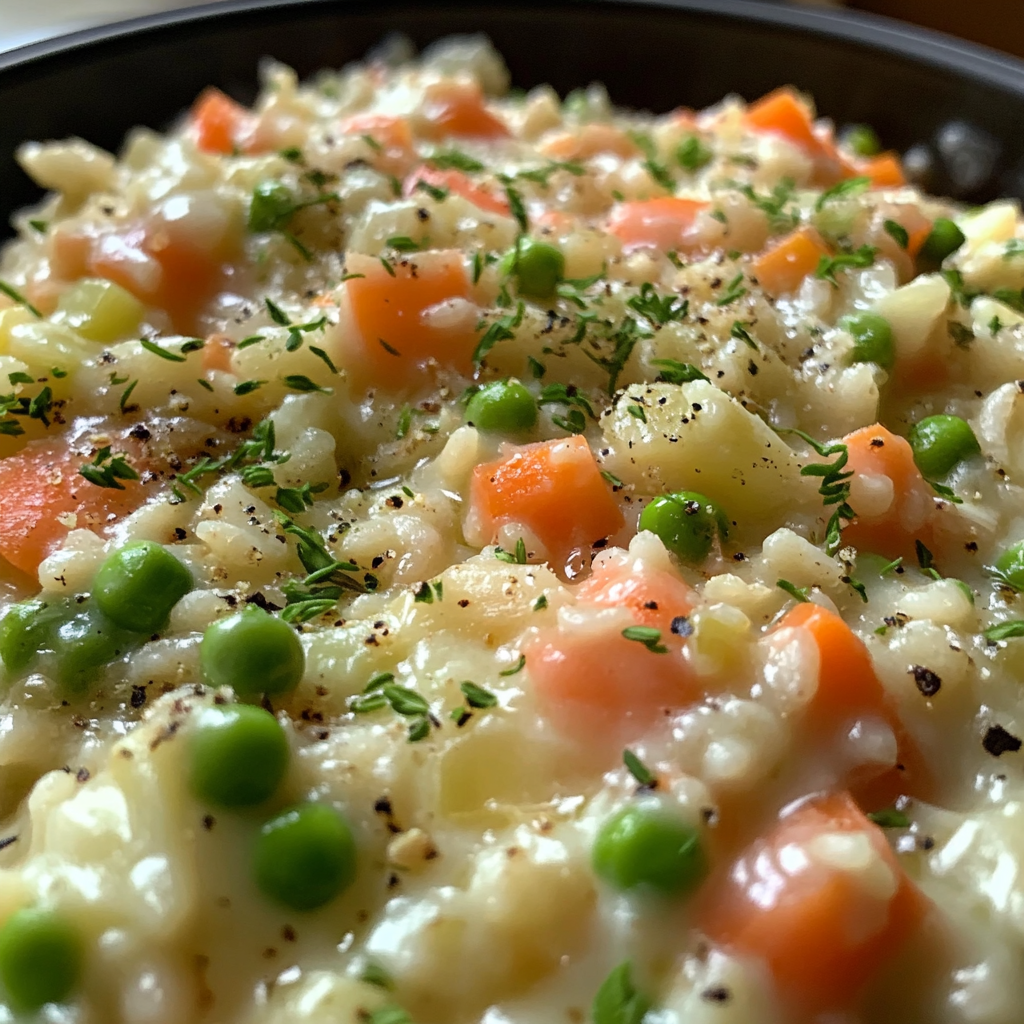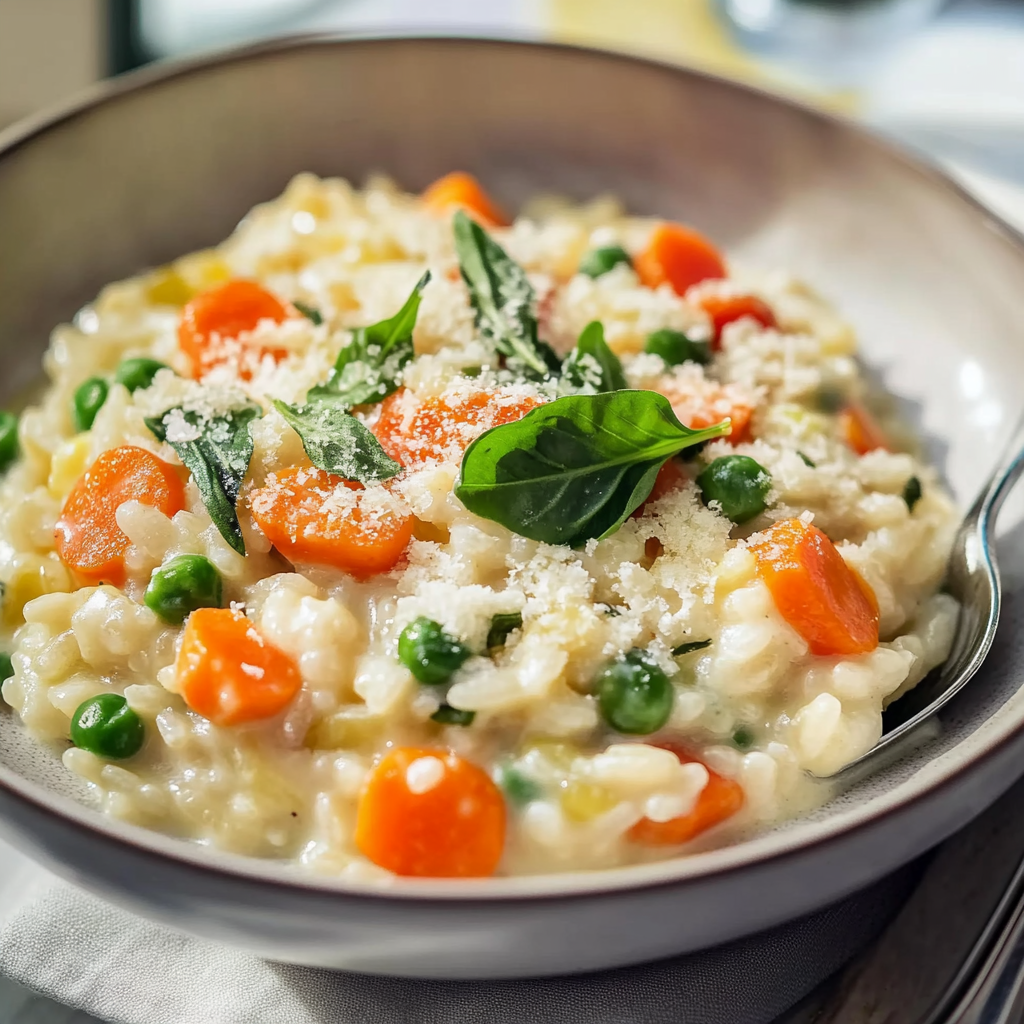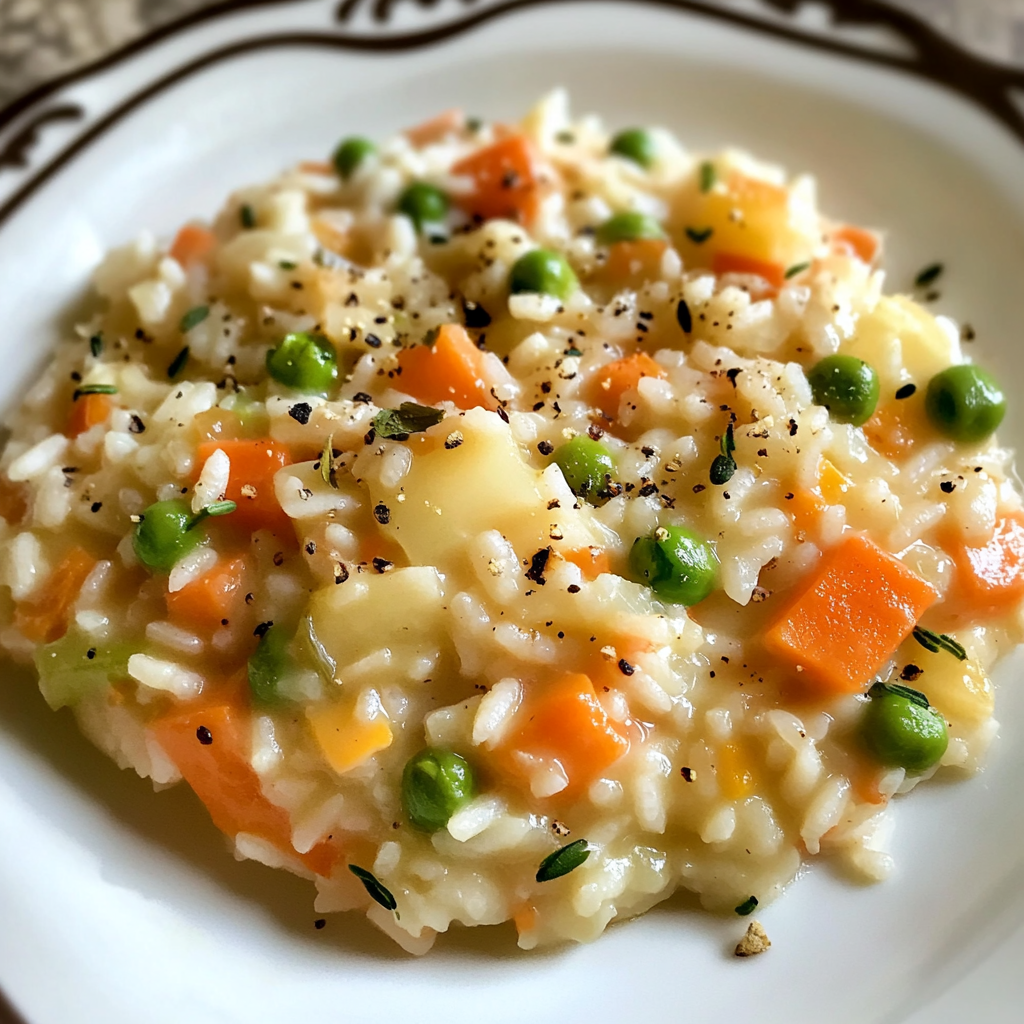Quick Overview
Spring is the perfect time to enjoy a light yet satisfying meal, and nothing captures the essence of the season quite like a bowl of Spring Vegetable Risotto. This dish combines creamy Arborio rice with an array of fresh vegetables that brighten any table. With its rich flavors and comforting texture, this Spring Vegetable Risotto will quickly become a favorite in your home. Let’s dive into the ingredients and steps to create this delicious dish!
Ingredient Breakdown
Arborio Rice
Arborio rice is a short-grain variety known for its high starch content. This starch contributes to the creamy texture that makes risotto so unique. You will need about 1 cup of Arborio rice for this recipe.
Fresh Asparagus
Asparagus adds a tender crunch and vibrant color to your risotto. Choose bright green stalks that are firm but not woody. You’ll need approximately 1 cup of fresh asparagus tips.
Peas
Fresh peas bring sweetness and a pop of color to the dish. If you can’t find fresh peas, frozen ones work well too. Use about 1 cup of peas for added freshness.
Zucchini
Zucchini is mild-flavored and absorbs surrounding flavors beautifully. It adds another layer of texture to your risotto. Slice up about 1 medium zucchini for this recipe.
Onion
Onion provides a savory base flavor for your dish. A small onion, finely chopped, will add depth to the overall taste of the risotto.
Garlic
Garlic adds aromatic richness and enhances the flavor profile of your dish. Use 2 cloves of fresh garlic, minced finely for optimal flavor infusion.
Vegetable Broth
Vegetable broth serves as the cooking liquid for your risotto, imparting additional flavor as it reduces. You will need about 4 cups of low-sodium vegetable broth.
Parmesan Cheese
Parmesan cheese adds creaminess and a salty finish to your risotto. Grate roughly ½ cup of freshly grated Parmesan cheese before serving for the best taste.
Olive Oil
Olive oil is essential for sautéing your vegetables at the beginning of the cooking process. Use about 2 tablespoons to achieve that flavorful base.
Salt & Pepper
Salt and pepper are crucial seasonings that enhance the overall flavor of your dish. Adjust these according to taste throughout the cooking process.
Step By Step Recipe: Spring Vegetable Risotto
Prepare Your Ingredients
Start by washing all your vegetables thoroughly under cold water. Chop the onion and zucchini into small pieces while snapping off the woody ends from the asparagus before cutting them into bite-sized pieces. Mince the garlic finely to ensure even distribution in flavor.
Sauté Vegetables
In a large saucepan or skillet over medium heat, add 2 tablespoons of olive oil. Once hot, add chopped onions and minced garlic; sauté until they turn translucent (about 3-4 minutes). Next, toss in zucchini and asparagus; cook until slightly tender (about another 5 minutes).
Toast Arborio Rice
Add 1 cup of Arborio rice directly into the pan with sautéed vegetables. Stir continuously for about 2 minutes until each grain is coated in oil and has become slightly translucent around the edges—this step helps release starches later during cooking.
Add Broth Gradually
Pour in approximately ½ cup of warm vegetable broth into the pan with rice and veggies; stir gently until absorbed completely (around 3-5 minutes). Continue adding broth gradually in this manner—stirring frequently—until all liquid is absorbed (totaling around 20-25 minutes).
Incorporate Peas
Once most of the broth has evaporated but before it becomes dry—around last five minutes—add in 1 cup of peas while stirring consistently throughout cooking time to ensure they stay vibrant green without overcooking.
Finish with Parmesan
When you’ve reached a creamy consistency where rice is al dente yet tender (and most broth absorbed), remove from heat; stir in grated Parmesan cheese until melted completely creating an even creamier texture throughout your Spring Vegetable Risotto.
Serving and Storing Tips
Serving Suggestions
Serve your Spring Vegetable Risotto hot with an extra sprinkle of freshly grated Parmesan on top for an added touch! Pair it with crusty bread or a side salad featuring seasonal greens for a complete meal experience that celebrates fresh flavors.
Leftover Storage
Store any leftover risotto in an airtight container in the refrigerator for up to three days maximum freshness retention! Reheat gently on low heat while adding splashes more vegetable broth or water if necessary—a quick stir should help restore its original creamy goodness!
With these detailed instructions and ingredient breakdowns, you can confidently prepare a delightful plate of Spring Vegetable Risotto that showcases all those beautiful seasonal veggies while keeping things simple! Enjoy every bite!
Mistakes to avoid
One common mistake when making Spring Vegetable Risotto is not using the right rice. Arborio rice is essential for achieving that creamy texture. Other types of rice may not absorb liquids properly, resulting in a dish that lacks the desired consistency.
Another mistake is adding all the broth at once. Instead, gradually add the liquid as you stir. This method allows the rice to absorb the flavors and release starch for creaminess. Adding too much broth too quickly can lead to a soupy risotto rather than a perfectly cooked one.
Overcooking vegetables is also a frequent error. You want your spring vegetables to retain some crunch and vibrancy. Add them towards the end of cooking, so they stay fresh and colorful. Overcooked veggies lose their nutrients and can turn mushy.
Failing to season adequately can ruin your Spring Vegetable Risotto. Taste your dish throughout the cooking process and adjust seasoning as needed. A well-seasoned risotto elevates its flavors, while blandness can leave it unappetizing.
Lastly, skipping the resting period after cooking is a mistake many home cooks make. Allow your risotto to sit for a few minutes before serving. This resting time helps meld flavors together and improves texture.
Tips and tricks
To create an outstanding Spring Vegetable Risotto, start with quality ingredients. Fresh seasonal vegetables like asparagus, peas, and spinach will provide vibrant flavors and colors that enhance your dish’s appeal. Choose organic produce when possible to ensure you’re using the best available options.
When preparing your broth, consider making homemade vegetable stock for optimal flavor. Homemade stock allows you to control salt levels and infuse more natural flavors into your risotto compared to store-bought options. If you’re short on time, choose low-sodium store-bought broth for a quicker solution while still enhancing your final dish.
Stirring consistently is crucial during cooking; it helps release starch from the rice, creating that signature creaminess without needing added cream or butter. Use a wooden spoon for stirring as it prevents scratching your pot’s surface, maintaining its quality over time!
Incorporate herbs like fresh basil or chives at the end of cooking for an extra layer of flavor in your Spring Vegetable Risotto. Fresh herbs brighten up the dish while providing aromatic notes that bring all ingredients together beautifully.
Finally, experiment with cheeses! While Parmesan is traditional, try adding goat cheese or mascarpone for unique flavor profiles. These cheeses will provide creaminess and richness that complement seasonal vegetables exceptionally well.
Suggestions for Spring Vegetable Risotto
Pair your Spring Vegetable Risotto with a light salad dressed in olive oil and lemon juice to balance flavors on your plate. The crispness of fresh greens contrasts nicely with the creamy risotto while adding additional nutrients.
Consider serving crusty bread alongside the risotto for those who enjoy dipping or scooping up every last bit of this delicious meal. A nice sourdough or whole grain loaf works well to complement the rich flavors of the dish.
For protein lovers, grilled chicken or shrimp makes an excellent addition to your Spring Vegetable Risotto as a topping or side dish. The smoky char from grilling pairs beautifully with delicate spring vegetables.
Another suggestion is to garnish with toasted nuts like pine nuts or almonds before serving for added texture and flavor depth in each bite of risotto.
Lastly, don’t forget about wine pairings! A glass of crisp white wine like Sauvignon Blanc enhances both taste components in this dish while creating a sophisticated dining experience at home.
FAQs
What type of rice should I use for Spring Vegetable Risotto?
The best choice for making Spring Vegetable Risotto is Arborio rice due to its high starch content that creates a creamy texture during cooking. This short-grain rice absorbs liquid effectively while remaining firm yet tender when cooked properly.
How do I prevent my risotto from becoming too dry?
To keep your risotto moist throughout cooking, gradually add warm broth instead of pouring it all at once. Stir consistently as you add liquid; this helps release starches from the rice, ensuring creaminess without excessive dryness.
Can I make Spring Vegetable Risotto ahead of time?
While it’s best enjoyed freshly made for optimal texture, you can prepare components ahead—like chopping vegetables or preparing broth—to streamline cooking later on. If making ahead entirely, store in an airtight container in the fridge but note it may lose some creaminess when reheated.
How do I store leftovers of Spring Vegetable Risotto?
To store leftover risotto effectively, place it in an airtight container after allowing it to cool down slightly at room temperature first. Refrigerate within two hours of cooking; consume within 2-3 days for best quality and safety precautions.
Can I use frozen vegetables instead?
Yes! You can use frozen vegetables if fresh ones are unavailable; however, be sure not to overcook them as they may release excess water into the risotto during preparation which could alter its final consistency undesirably.
Is it possible to make a vegan version of Spring Vegetable Risotto?
Absolutely! To create a vegan version of this dish simply replace dairy-based cheese with plant-based alternatives such as nutritional yeast or vegan cream cheese while using vegetable broth instead of chicken broth during preparation!
Summary
Spring Vegetable Risotto allows you to celebrate seasonal produce with delightful textures and flavors. Avoid common mistakes such as using incorrect rice or adding too much broth at once by following clear tips throughout preparation processes outlined above! Don’t forget suggestions like pairing dishes alongside salads or proteins which elevate dining experiences further—while FAQs help clarify any uncertainties surrounding this delicious recipe! Enjoy crafting your perfect bowl today!
Spring Vegetable Risotto
Description
Spring is the perfect time to enjoy a light yet satisfying meal, and nothing captures the essence of the season quite like a bowl of Spring Vegetable Risotto. This dish combines creamy Arborio rice with an array of fresh vegetables that brighten any table. With its rich flavors and comforting texture, this Spring Vegetable Risotto will quickly become a favorite in your home. Let’s dive into the ingredients and steps to create this delicious dish!
Ingredients
Arborio Rice
Arborio rice is a short-grain variety known for its high starch content. This starch contributes to the creamy texture that makes risotto so unique. You will need about 1 cup of Arborio rice for this recipe.
Fresh Asparagus
Asparagus adds a tender crunch and vibrant color to your risotto. Choose bright green stalks that are firm but not woody. You’ll need approximately 1 cup of fresh asparagus tips.
Peas
Fresh peas bring sweetness and a pop of color to the dish. If you can’t find fresh peas, frozen ones work well too. Use about 1 cup of peas for added freshness.
Zucchini
Zucchini is mild-flavored and absorbs surrounding flavors beautifully. It adds another layer of texture to your risotto. Slice up about 1 medium zucchini for this recipe.
Onion
Onion provides a savory base flavor for your dish. A small onion, finely chopped, will add depth to the overall taste of the risotto.
Garlic
Garlic adds aromatic richness and enhances the flavor profile of your dish. Use 2 cloves of fresh garlic, minced finely for optimal flavor infusion.
Vegetable Broth
Vegetable broth serves as the cooking liquid for your risotto, imparting additional flavor as it reduces. You will need about 4 cups of low-sodium vegetable broth.
Parmesan Cheese
Parmesan cheese adds creaminess and a salty finish to your risotto. Grate roughly ½ cup of freshly grated Parmesan cheese before serving for the best taste.
Olive Oil
Olive oil is essential for sautéing your vegetables at the beginning of the cooking process. Use about 2 tablespoons to achieve that flavorful base.
Salt & Pepper
Salt and pepper are crucial seasonings that enhance the overall flavor of your dish. Adjust these according to taste throughout the cooking process.





